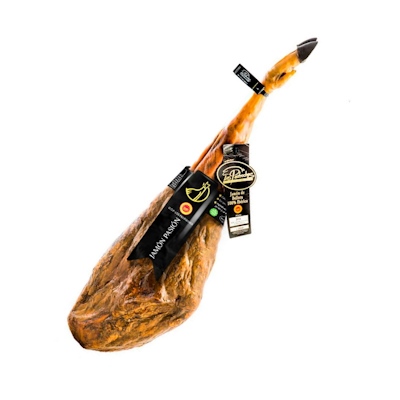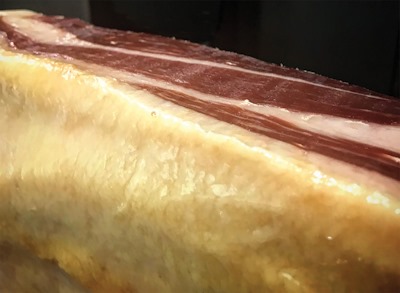It is not difficult to choose a good Iberian ham. Just by following a few tips, you will have the keys to know if the ham you want to buy meets the quality you expect, that is, the best in its category. There are several aspects to take into account so that when buying a good Iberian ham, the percentage of success is almost 100%, especially if you are going to spend a lot of money.
Below I will explain the keys to know if an Iberian ham is of good quality. What you should look for externally; what the internal appearance should be like once you have started, etc., but let's start with the different types of Iberian hams that are produced.
Types of Iberian hams
If you are a follower of the Jamón Pasión blog or a regular consumer of Iberico ham legs, you will know that there are 4 different categories that refer to the type of feeding and breeding, as well as to the purity of the Iberian pigs. Each category is also marketed with a specific minimum weight. They cannot have a lower weight than the one established by the regulations. If you need more information on this subject, you can go to this article.
In today's blog we are going to talk about the different types of Iberian hams, but from an organoleptic point of view, that is, their aromatic properties, texture and flavour.
- Pata Negra Ham (Acorn-fed 100% iberico)
It is the highest quality of the whole range of Iberian hams, the jewel in the crown. The most desired, acclaimed, known and recognised internationally, and of course, the most sold Spanish ham at Christmas. It is identified by the black label around the hoof.
The first thing to bear in mind is the amount of fat in all the legs of Iberian ham, which is much greater than that of a Serrano ham, both surface fat surrounding the piece, and fat infiltrated into the meat, the famous marbling.
Of all the categories, 100% Iberian acorn-fed ham is the one with the least infiltrated fat (bearing in mind that, being Iberian, it already has a good infiltration). The higher the purity of the Iberian breed, the higher the percentage of lean meat. On the contrary, it has more peripheral fat and thanks to this good layer of fat, the curing process is longer, achieving those aromas, nuances and delicate notes in its meat.
- Iberian Bellota Ham
Acorn-fed Iberian ham has the same characteristics as pata negra, except for the percentage of intramuscular fat. Being a ham with a purity of Iberian breed between 50% and 75%, its infiltration will be greater, since they are crossed with Duroc pigs, breeds with very good fat infiltration, resulting in a juicier and more flavorful meat. and less delicate, but more powerful smell.
It is identified by the red label around the hoof. It is a very good option to take into account when choosing and buying a good Iberico Spanish ham.
- Iberian Cebo de Campo Ham
This category includes hams made from pigs that have not been fed on acorns, but have been reared in the open air like the previous ones and have had access to the wild pastures of the countryside, hence the name "Cebo de Campo". It is identified by the green label around the hoof.
It is a ham of the highest quality, with an intense flavour and aroma and hints of wild herbs. They have a medium-high price, but are cheaper than acorn-fed hams.
Its fat infiltration depends, like all Iberian hams, on the percentage of Iberian breed, and in this range you can find 50% and 100% Iberian hams, being the 50% the most commercialised.
- Iberian Cebo Ham
All Iberian hams are of good quality, but the Cebo Iberian ham is the little brother. The difference is not due to the breed, which, like the other categories, can vary between 50% and 100%, but to the way it is fed and reared. It is identified by the white label around the hoof.
These hams are obtained from pigs reared on farms, unlike the rest, which are reared in the open air. For this reason, they do not have access to the food resources that the countryside has to offer and are fed exclusively on cereals. Due to this difference in handling and feeding, their flavour is not as delicate and does not have those subtle nuances that the others have, especially those of acorn-fed hams.
It is still a good iberico ham with a very good intensity of flavour, aroma and a fantastic texture.
External appearance of Iberian ham

The physical appearance of Iberian ham varies subtly from one category to another, but when contrasted with a non-Iberian ham leg, the following distinguishing characteristics can be identified:
1. Morphology
The external appearance of Iberico hams is characterised by the fact that the leg is more elongated, with a smaller diameter in the part closest to the hoof, the shank. The overall length of the ham is longer than that of hams not produced by Iberian pigs, and the large part of the leg that holds the meat is not so rounded, but tends to be longer.
These particularities become even more accentuated as the degree of Iberian purity increases. Therefore, a 100% purebred Iberian ham will exhibit a thinner and more stylised leg compared to a less purebred ham.
2. The hoof
When the hoof of the ham leg shows signs of wear, it indicates that the pig has enjoyed a life in the open air, grazing and roaming the pastures or fields. It is important to note that only Iberian ham from pigs reared in free-range conditions, such as free-range and acorn-fed hams, exhibits these characteristics more clearly.
3. Palpation
An Iberian ham with a well-balanced curing process should not offer much resistance when you try to press it with a finger, yielding to pressure and leaving a slight mark.
It is important to note that the narrow part of the ham that is found if we place the ham on the ham stand with the hoof downwards, which we call the "babilla", is the driest section and has less fat infiltration, so it will feel much firmer to the touch compared to the area of the "maza", which is much juicier and has a higher fat content.
4. Colouring
An Iberian ham in optimum condition should exhibit a surface with brownish tones, which may vary in intensity, even reaching yellowish or golden tones. The presence of mould does not indicate poor quality, in fact, it is common in drying sheds and is a natural consequence of the maturation process, due to the humidity created in the dehydration phase.
Interior appearance of the ham

Starting from the premise that a ham has an identifying label that certifies and guarantees the Iberian breed, the feed and the origin of the pig, sometimes, some hams may not have been cured as well as we would like, and we cannot know this until we start to cut it. Once you have started, you can also take into account some aspects to measure if the Iberian ham is of good quality.
1. Lean and fat
A variety of shades can be noted in the meat and fat. In general, the lean part will have a reddish tone, while the fat will show a yellowish-white tone, even golden on the outside. In hams that do not contain additives, these colours will be fainter, reminiscent of pale pink. In contrast, the additives, among their functions, include enhancing and fixing the colours, giving rise to more vibrant shades approaching purple-red. Importantly, this has no impact on taste quality, texture or aroma.
2. Fat infiltration
The marbling, the famous fat infiltration in the meat of Iberian pigs, is inversely related to their racial purity, which means that the greater the purity, the less fat infiltration. Despite the common belief that an Iberian acorn-fed acorn-fed ham will contain more fat infiltration than a leg of cebo de campo ham, the reality is different.
The meat of a 100% Iberian pig is leaner compared to that of a 50% purebred Iberian pig. However, it is the outer layer of fat that increases significantly in purebred Iberian pigs. Therefore, all hams should exhibit this characteristic of marbling, but if you are looking for exceptional infiltration, it would be best to opt for a 50% Iberian ham.
When making your choice, you should take into account your personal tastes. Some diners do not like to taste a higher percentage of fat in the mouth and prefer a leaner texture.
3. Aroma
The ham should emit a bouquet with fragrances of cured meat, smoked meat and salt, with sweet and spicy touches. In the case of acorn-fed hams, which include pata negra hams, they usually express aromatic notes of nuts, acorns and the herbs of the pasture. The full release of these aromatic nuances is best achieved with thinner slices and always at room temperature.
4. The Flavour
It is closely attuned to the aroma, exhibiting identical notes and nuances. It is crucial to remember that the sense of smell plays a fundamental role in the perception of taste, since without smell, there is no true taste. On the palate, it manifests itself with persistence, leaving an aftertaste in which the four fundamental tastes can be discerned: sweet, salty, bitter and sour. It has even been suggested recently that a fifth taste is added: Umami.
It should be borne in mind that everything described here will have a greater connotation in acorn-fed hams and a lesser connotation in Cebo iberico hams.
5. White points
Many people question the white spots that appear inside the ham, resembling salt crystals, although they are not related to this at all. These spots are actually thyroxine, an amino acid found in proteins, in this case casein. Their presence is a consequence of the extensive maturation process of these products and signals high quality, indicating that the ham has been cured over a long period.
Final advice
Bearing in mind these small notes, it is very difficult to go wrong when buying a good quality Iberian ham. With a simple glance in an online ham shop or in your local supermarket to check that the labels are on, the flanges are of a distinctive colour and the weight is in accordance with its category, you can be sure that the ham complies with the law, which guarantees fairly strict quality requirements. If, once opened, the product has any objective defect, the product should be replaced.
Although with small differences, these parameters and advice can also be applied to ham shoulders or pork shoulders.
At Jamón Pasión we are at your disposal to clarify any doubts you may have in this regard and we will be delighted to give you all the information you need to choose the ham that best suits your needs.
